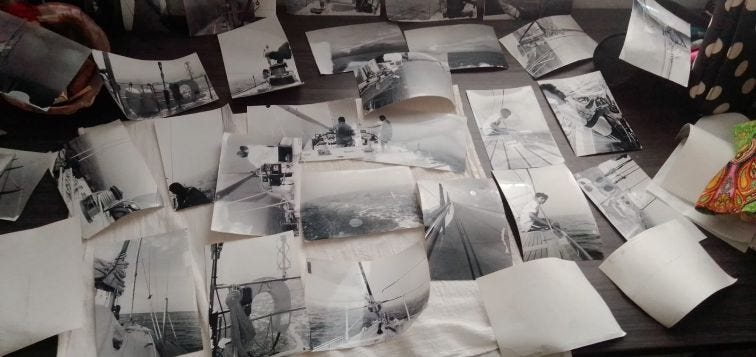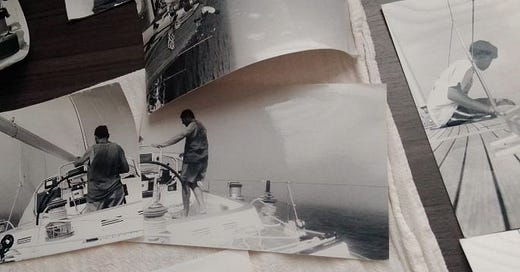Remember Photo Negatives?
Did a friend forward this to you? Subscribe here!

To Behold the Past In Our Hands

A few months ago, I found several pockets of black and white photographs taken during my high school days, back when I was obsessed with darkroom photography. I dragged my grandfather’s ancient manual camera with me everywhere I went, deciphering the best way to coax a perfect photograph from the complex suite of settings—F-stop, aperture, focus, lenses.
I was thrilled to find the photographs, mainly because they were taken during a multi-week sailing trip I took with my father along the eastern seaboard, from Miami to Newport, RI. Unfortunately, the photographs had been through a flood and were all stuck together in one, solid mass of pigment and photo paper. Broken-hearted, I was close to giving up on them when my mother offered a solution: “Soak them in water,” she said.
That makes sense, I thought. I knew from my darkroom days that photographs were created in baths of chemicals and water, so they were in some sense water-proof. I vowed to give it a try, and this weekend, I finally got around to the task.
I immersed the block of photos—photographs dear to me, for the many iconic shots of my sailboat captain father—into water and held my breath. Over the course of two days, I slowly and painstakingly peeled the stuck photographs apart, some attempts more successful than others. In a way, it reminded me of the hours I spent in the darkroom, peering into the water as images appeared like magic on blank paper. Except this time, I was scraping away streaks of paper and glue that clouded the pictures, the image beneath it revealed in time—sails billowing in the wind, my father’s smile as he stands at the helm, the deep horizon beyond the bow.

We’ve lost the physicality of photographs. The whole process happens so quickly now—snap and shoot, the process of development reduced to milliseconds instead of hours in the dark—first to make the negatives, and afterwards, to make prints of those negatives. Each photograph carries with it a weight: the weight of effort and time and a dash of enchantment.
I listened to an interview with the poet, Ocean Vuong, this weekend, during which he spoke about a photograph printed on the cover of his book, Night Sky With Exit Wounds. “Three cups of rice for that photo,” he explains. That’s what his family paid to have the picture taken in a refugee camp in the Philippines—a whole day’s rations. “What was it about these women,” Vuong muses, “that would surrender their very sustenance in order to preserve their image?”

I’ve written before about my preference for the hold-in-your-hand picture versus the jpeg file on my hard drive, but somehow, that preference was challenged as I tried again and again to salvage these precious photographs—a task that took on a different weightiness with the recent loss of my father, the ocean of grief that I continue to navigate through every day. If only I had scanned them. If only I had taken them with a digital camera instead.
But then I remembered the external hard drive that perished for no apparent reason, taking with it years and years of photographs—all of my travel throughout my twenties. When that happened, I’d wished that I’d favored the analog version of image-making, rather than the pixelated, computer-generated alternative.
Staring at these photographs, some of them worse for the wear, tears sprang to my eyes as I was immediately transported back to those days of salt and sunshine, endless hours and horizons. Time spent in the presence of my father, time I could never get back, but time that I could somehow hold in my hand as I inspected every photograph closely, grief having made me hungry for details, no matter how mundane.
We are living in a time of visual excess. Within a few seconds, we can snap a photo, doctor it up, and share it with friends, family, or followers. We spend hours mindlessly scrolling through an ocean of visuals, each photo designed to capture our attention, if only for a split second. We might hit the heart button before scrolling on. And it makes me wonder—what have photographs been reduced to now that the magic—and mindfulness—has been removed from the equation?
Tip of the Week
In an effort to liberate precious photos from the digital sphere, I’ve taken on the laborious task of designing and printing physical photo albums of my favorite pictures: trips, events, random moments. Perhaps you feel inspired to do the same! I use Snapfish because they make gorgeous products and have great deals, but even CVS photo makes it easy to create awesome photo albums.
It only took me two years to make our wedding album, but I love flipping through the pages and pointing at funny pictures. I think I feel more compelled to do so with a baby on the way. I think about how much joy I’ve gotten throughout my life to comb through photo albums of my parents’ life before my sister and I came along, to get a window into what the world looked like in my infancy—and I want to give that gift to our children.
If you enjoy this newsletter, please
Thanks for reading!




